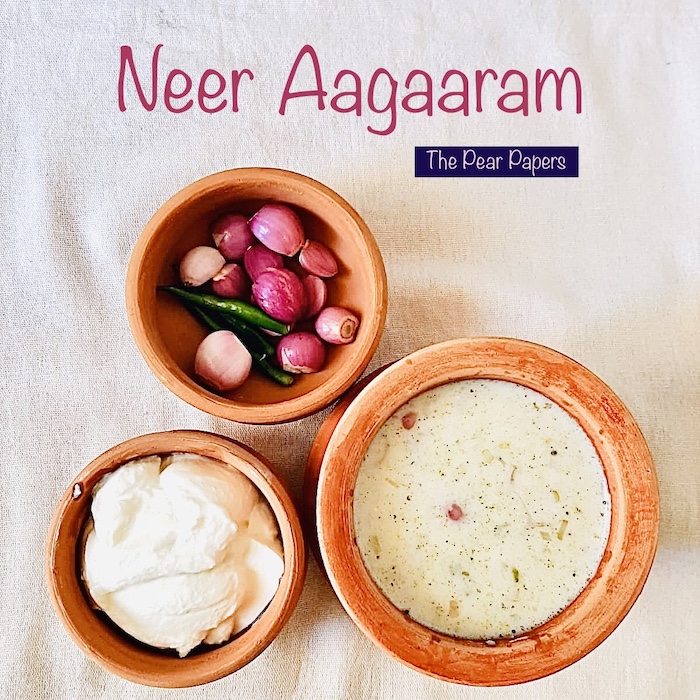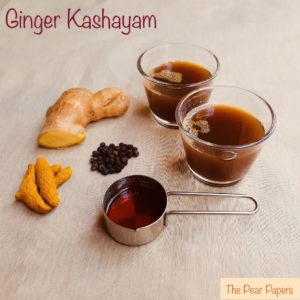
Neer Aagaaram
Neer Aagaaram, in Tamil, literally translates to ‘Watery Food’. It is basically made with cooked rice, that is cooled to room temperature, soaked fully in plain water and left overnight to ferment. During this time the rice ferments, generating trillions of gut friendly bacteria. Both the fermented rice and the water in which it is soaked, is consumed for breakfast along with some salt, plain yoghurt, small onions (shallots) and green chillies (optional). It is a highly underrated, savoury breakfast dish that falls in the superfood category.
Neer Aagaaram improves digestion, builds immunity, provides vitamin B6 and B12, enhances availability of micronutrients such as iron, potassium and calcium many folds and reduces many stomach related problems like acidity, bloating, heaviness, to name a few. It gives a lot of energy and cooling effect to those who go out in the sun for manual labour. The nutritional benefits of fermented rice is highly disproportionate to the effort it takes to make. And what’s more, it’s absolutely delicious!
Ingredients
Cooked rice – 2 cups
Plain yoghurt – 1 cup
Water – as required
Baby onions/shallots – 10 to 12 finely chopped
Salt – 1/2 tsp
Green chilly – 1 finely chopped (optional)
Ginger – 1 inch piece finely chopped or grated (optional)
Cooking sesame oil – 1 tbsp
Mustard seeds – 1/2 tsp
Sprouted fenugreek seeds – 2 tbsp (optional)
Dried curry leaves powder – 1 tsp (optional) or few fresh curry leaves finely chopped
Yield
Serves 3
Prep time
Overnight soaking
Making time
10 minutes
Method
1) Soak the cooked rice in an earthen pot (if you have one) with enough water to cover the rice. Cover and leave overnight at room temperature.
2) Next morning the rice will be fermented. Sometimes you may even see small bubbles from the fermentation process. Slowly transfer the excess water, if any, to a different vessel and keep it aside. With clean hands mash the rice slightly so it becomes like cooked porridge.
3) Add salt, yoghurt, dried curry leaves powder (or fresh curry leaves), sprouted fenugreek seeds and mix once. Set aside.
(See fenugreek grape pickle recipe and banana stem mung sprouts curry recipe for tips to sprout fenugreek seeds.)
4) In a small pan, heat the sesame oil until medium hot and add mustard seeds. Let it splutter. Then add green chillies and ginger, fry for 30 secs. Immediately add the onions and fry just for 30 secs. Transfer this tempering to the rice-yoghurt mixture. Mix well.
5) Now add back the drained fermented water to the rice mixture. Your Neer Aagaaram is ready. If needed, add more water to dilute and bring the Neer Aagaaram to drinking consistency. Serve immediately, it cannot be stored.
Notes
- Green chilly, ginger, sprouted fenugreek seeds and curry leaves are optional ingredients. Neer Aagaaram tastes perfectly fine even without these four ingredients. But I personally prefer to add green chilly and ginger to give that extra zing to my morning breakfast. Curry leaves and sprouted fenugreek seeds are added purely to enhance the nutritional value of this dish.
- You can ferment red rice, brown rice, traditional rice varieties or millets too in the same method.
- Using clay pots to ferment rice is the best option. The natural pores in the clay increases the air circulation inside the pot which helps better fermentation, and thereby increases the production of gut friendly bacteria. It also gives a pleasant cooling effect to the Neer Aagaaram without any refrigeration. If you don’t have an earthen pot, it’s fine. Go ahead and ferment the rice in a porcelain/stainless steel or glass container. Please avoid nonstick or plastic containers when fermenting.
- Adding plain yogurt to fermented rice increases the probiotic content of this dish. For vegan options, you can either use vegan yoghurt or just skip the yoghurt.
- Don’t ferment the rice beyond 12 hours. It might start to spoil beyond that, depending on the weather.


You May Also Like

Ginger Kashayam
April 27, 2020
Fruity Coconut Mocktail
August 1, 2021